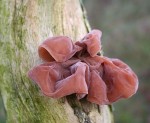 Jew’s ear, also called wood ear and jelly ear, grows in deciduous and coniferous woodlands in the warmer parts of the northern temperate zones. It lives on dead or living wood, especially elder, and can appear any time of year but is most likely to be seen in winter and spring. The fruiting body is one to three inches across and may be cup- to ear- shaped. It is smooth and gelatinous at first but becomes hard and folded as it matures. The color varies with age from dark red, to reddish brown or gray-brown, sometimes with a tinge of green. The spore bearing layer, is veined, wrinkled, and faces downward. The stem, if present, is lateral. The spores are white.
Jew’s ear, also called wood ear and jelly ear, grows in deciduous and coniferous woodlands in the warmer parts of the northern temperate zones. It lives on dead or living wood, especially elder, and can appear any time of year but is most likely to be seen in winter and spring. The fruiting body is one to three inches across and may be cup- to ear- shaped. It is smooth and gelatinous at first but becomes hard and folded as it matures. The color varies with age from dark red, to reddish brown or gray-brown, sometimes with a tinge of green. The spore bearing layer, is veined, wrinkled, and faces downward. The stem, if present, is lateral. The spores are white.
Although Jew’s ear mushroom is considered edible when young before it becomes tough and gristly with age, it is not considered highly desirable because of its bland flavor. It can be used in mixed mushroom dishes or dried for later use, but should also always be cooked. A closely related species, Hirneola polytricha, also known as Cloud Ear, is used extensively in Chinese, Vietnamese, and Japanese cuisine because it goes well with rice dishes as well as meat and fish.
The common name, Jew’s ear, comes from the resemblance of the fruiting body to an ear, and the fact that Judas Iscariot hung himself from an elder tree after he betrayed Jesus.